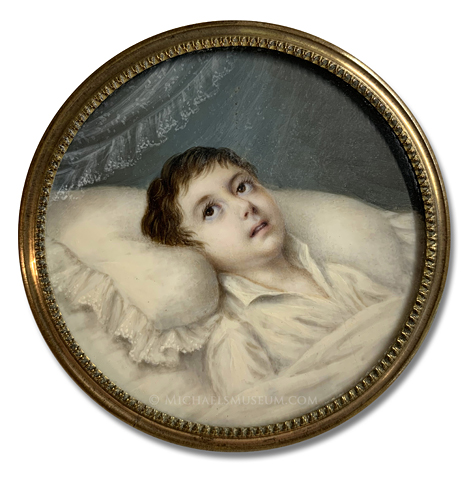| |
French: Artist Unknown


Sickly-Looking, Mid-Nineteenth Century Boy,
Depicted Lying in What is Likely His Deathbed
Believed to be French
circa 1840
Artist unknown
2 1/2 inches diameter (sight)
watercolor on ivory; housed under glass in a gilt metal surround
While the subject matter of this portrait seems macabre or distasteful by twenty-first century standards, death bed and postmortem portraits (both painted and photographic) were very common in the nineteenth and even early twentieth centuries. No doubt, such mementos were cherished by the parents and other family members of the subjects depicted.


Carte-de-Viste Photograph of a Sickly Looking,
Late Victorian Era Boy, Lying in What Was Likely His Deathbed
English
circa 1895
photograph by George Thomas Youdon Dickinson (1857-1924),
of Sheffield, Yorkshire, United Kingdom
2 3/8 x 3 13/16 inches (image was clipped at some point,
likely to make it easier to fit in an album)

Reverse of the carte-de-viste photograph
Curator Notes: The above miniature portrait was acquired for the collection in 2015. The carte-de-viste photograph was acquired a decade later, in 2025. While the two portraits are of a different time and a different media (one being painted in watercolor on ivory, and the other a photograph on card), they depict similar images and pair very well.
The subject matter of both images seems somewhat macabre today, but death bed and postmortem portraits (both painted and photographic) were very common in the nineteenth and even early twentieth centuries. No doubt, these mementos were cherished by the respective boys' families; and although their identities are now lost to time, the boys' sickly visages remain and continue to evoke emotion in the anonymous modern viewer.
About the Photographer of the Carte-de-Viste: George Thomas Youdon Dickinson was born in Birmingham, England on January 29, 1857, where his father worked as a professor of music. Upon the death of his father in 1866, his widowed mother relocated the family to Sheffield, Yorkshire, where both she and her late husband had been born and raised. Having shown an artistic bent from his youth, George T. Y. Dickinson was recorded in the 1871 England Census as being employed as a designer, at the young age of 14. He subsequently took up photography and styled himself as being a photographic artist. In 1879, he married his first wife, Louisa Elizabeth Jubb. In the mid 1880s, the couple purchased a home at 327 Glossop Road, in Sheffield, where George operated a photographic studio on the ground floor. In recognition of his photographic achievements, he was elected as a Fellow of the Royal Photographic Society in 1895. In 1898, after the death of his first wife, George married his young photographic assistant, Alice Maud Mackenzie, with whom he would have four children over the next decade. In 1901, the Dickinsons' Glossop Road home and George's photographic studio were destroyed in a catastrophic fire that consumed all his cameras, negatives and other photographic equipment. It was reported at the time that chemicals used by Dickinson in his business exploded when exposed to flames and that the explosion could be heard as far as a half mile away.* Insurance proceeds allowed the family to rebuild their home and Dickinson's studio; and he continued to operate successfully at 327 Glossop Road until his death on April 19, 1924, at the age of 67. He was buried at the Christ Church Churchyard cemetery, in Fulwood, Sheffield.
[*“News & Notes” (article), as appeared in “The British Journal of Photography”, January 25, 1901 edition, Vol. XLVIII, No. 2125, page 69.]
|
|